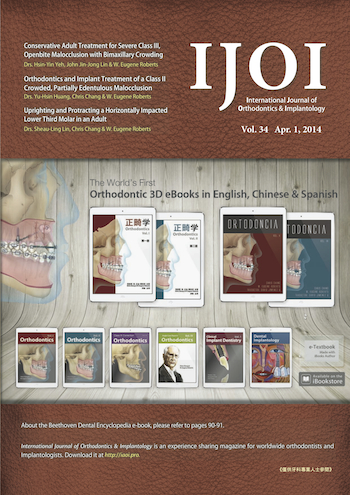IJOI Vol. 34

Introduction for the iBook of Chris Chang's Angle Cases
Roberts WE
This iBook is a compilation of case reports that Dr. Chris Chang presented in partial fulfillment of the requirements to become an active member of the Midwest Component of the Edward H. Angle Society of Orthodontists (EHASO). Understanding this professional accomplishment, as well as Chris's longtime a nity for the ideals of Dr. Angle, is facilitated by the remarks of Dr. George W. Hahn at the 25th anniversary of the EHASO. (Int J Orthod Implantol 2014;34:4-8)
Conservative Adult Treatment for Severe Class III, Openbite Malocclusion with Bimaxillary Crowding
Yeh HY, Lin JJ, Roberts WE
SUMMARY
A 24-year-old woman presented for orthodontics evaluation of a severe Class III malocclusion, that was complicated with an an anterior open bite, marked crowding in both arches, and lower lip protrusion. Maxillary first premolars and mandibular first molars were extracted. Differential space closure with a fixed, self-ligating appliance was supplemented with short, light Class III elastics. These conservative mechanics retracted the mandibular dentition to correct the negative overjet, reduced the buccal discrepancy and corrected the lower lip protrusion. In addition, the short, light Class III elastics produced a differential moment on the mandibular dentition to rotate the plane of occlusion counterclockwise, to correct the anterior open bite. This severe Class III malocclusion with a Discrepancy Index of 60 was corrected to an excellent functional and esthetic result, as documented by a Cast-Radiograph Score of 20, and a Pink and White Esthetic Score of 2. (Int J Orthod Implantol 2014;34:12-25)
Key words: Class III openbite malocclusion, bimaxillary crowding, atypical extraction, self-ligating appliance
Download Article
Orthodontics and Implant Treatment of a Class II Crowded, Partially Edentulous Malocclusion
Huang YH, Chang CH, Roberts WE
SUMMARY
An adult female presented with a compensated Angle Class II malocclusion complicated by severe crowding, posterior crossbite and absence of five permanent teeth. An extended period of dental neglect resulted in a severe asymmetric malocclusion with major discrepancies in the vertical, transverse, and anterior-posterior dimensions. A self-ligating appliance with bite turbos and bone screw anchorage achieved a preprosthetic alignment consistent with the patient’s desire for normal function and pleasing esthetics. However, a bite turbo on the maxillary left lateral incisor was associated with pulp necrosis, internal resorption and an unrestorable tooth fracture during orthodontics treatment. The fractured tooth was temporarily restored by bonding the factored crown to the adjacent teeth. Cone bean CT images were taken, and one month later the fractured incisor was gently extracted. An implant was placed with a surgical stent via a flapless approach, and Platelet Rich Fibrin (PRF) was used to fill the apical fistulous tract and the gap between the fixture and the alveolar crest of bone. An immediate provisional restoration was used to restore optimal esthetics and function, as well as to serve as a guide for optimal healing of soft and hard tissue. (Int J Orthod Implantol 2014;34:30-55)
Key words: Angle Class II malocclusion, deep bite, posterior crossbite, multiple missing teeth, self-ligating appliance, bite turbo, internal root resorption, fatigue fracture, bone screw anchorage, atraumatic extraction, immediate implant placement, surgical stent, Platelet Rich Fibrin (PRF), immediate provisional restoration
Download Article
Uprighting and Protracting a Horizontally Impacted Lower Third Molar in an Adult
Lin SL, Chang CH, Roberts WE
SUMMARY
This case report for an adult male presents an innovative treatment modality to manage an acquired malocclusion that was associated with a poor dental prognosis for multiple molars. Compromised upper right and lower left 1st molars were extracted. The lower left third molar was a deep horizontal, bony impaction that was uncovered and uprighted. The asymmetric first and second molar extraction sites were closed by molar protraction. Through this dental conservation approach, the patient maintained a full dentition of healthy teeth and avoided the need of artificial prostheses. (Int J Ortho Implantol 2014;34:58-77)
Key words: Atypical extraction, impacted molar uprighting, surgical exposure, closed eruption technique, ramus screws, molar space closure
Download Article
Bimaxillary Protrusion Treated with Miniscrews
Huang TK, Chang CH, Roberts WE
SUMMARY
This report describes a conservative orthodontic treatment of a bimaxillary protrusion adult case. After four first premolars extraction, two bone screws were laced in the infrazygomatic crests to ensure maximal retraction and two additional bone screws were placed in between the central and lateral incisors for the vertical control of the maxillary anterior segment. Pleasing esthetic and functional results were achieved. (Int J Ortho Implantol 2014;34:78-89)
Key words: Bimaxillary protrusion, miniscrew
Download Article